Microeconomic Decision Making: Scarcity and Cost Analysis in the UK
VerifiedAdded on 2023/06/12
|11
|3050
|356
Report
AI Summary
This report explores the impact of resource scarcity and opportunity cost on microeconomic decision-making for households and individuals in the UK, referencing Krugman & Wells' textbook. It uses real-world examples from 2019-2021, such as COVID-19 vaccine scarcity and personal investment choices, to illustrate these concepts. The report identifies challenges like the cost of ownership, financial illiteracy, water scarcity, urbanization, and lack of education/skills as significant hurdles for households. Furthermore, it examines how cost-benefit analysis and incentives influence decisions, providing examples like development projects and government subsidies. The report also analyzes how businesses leverage consumer habits related to cost-benefit analysis and incentives to drive profits, highlighting the interplay between market economy dynamics and individual choices. The document is contributed by a student and available on Desklib with study tools.
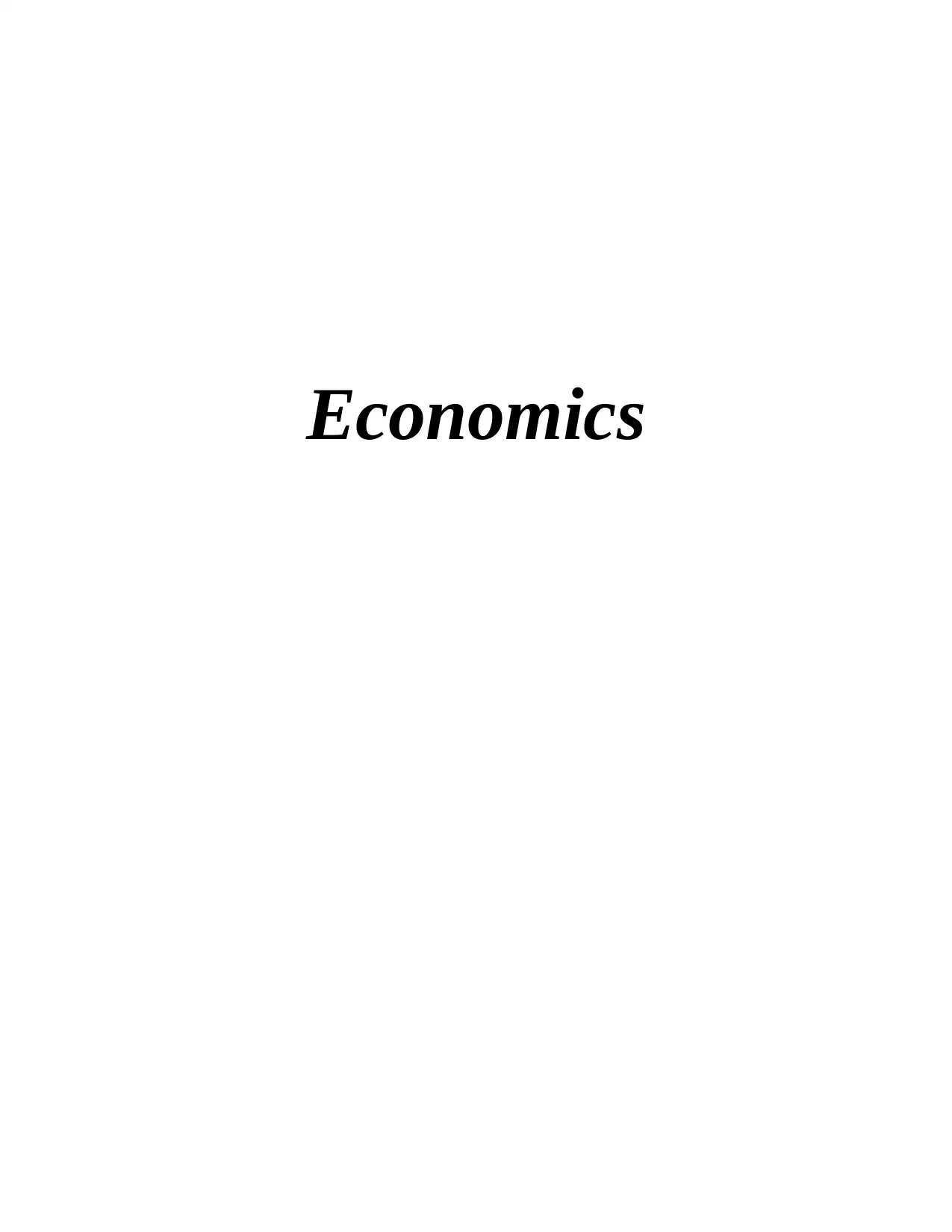
Economics
Paraphrase This Document
Need a fresh take? Get an instant paraphrase of this document with our AI Paraphraser
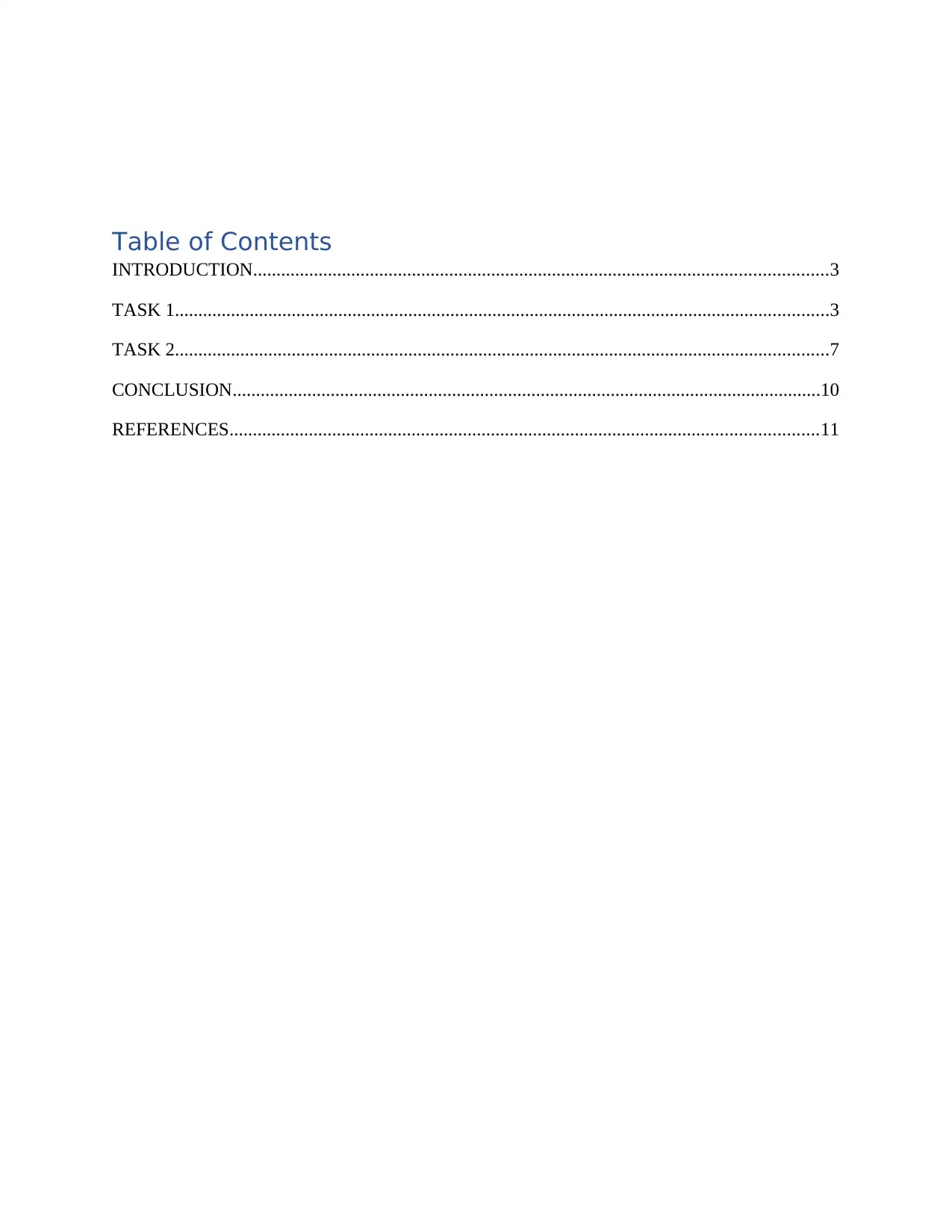
Table of Contents
INTRODUCTION...........................................................................................................................3
TASK 1............................................................................................................................................3
TASK 2............................................................................................................................................7
CONCLUSION..............................................................................................................................10
REFERENCES..............................................................................................................................11
INTRODUCTION...........................................................................................................................3
TASK 1............................................................................................................................................3
TASK 2............................................................................................................................................7
CONCLUSION..............................................................................................................................10
REFERENCES..............................................................................................................................11
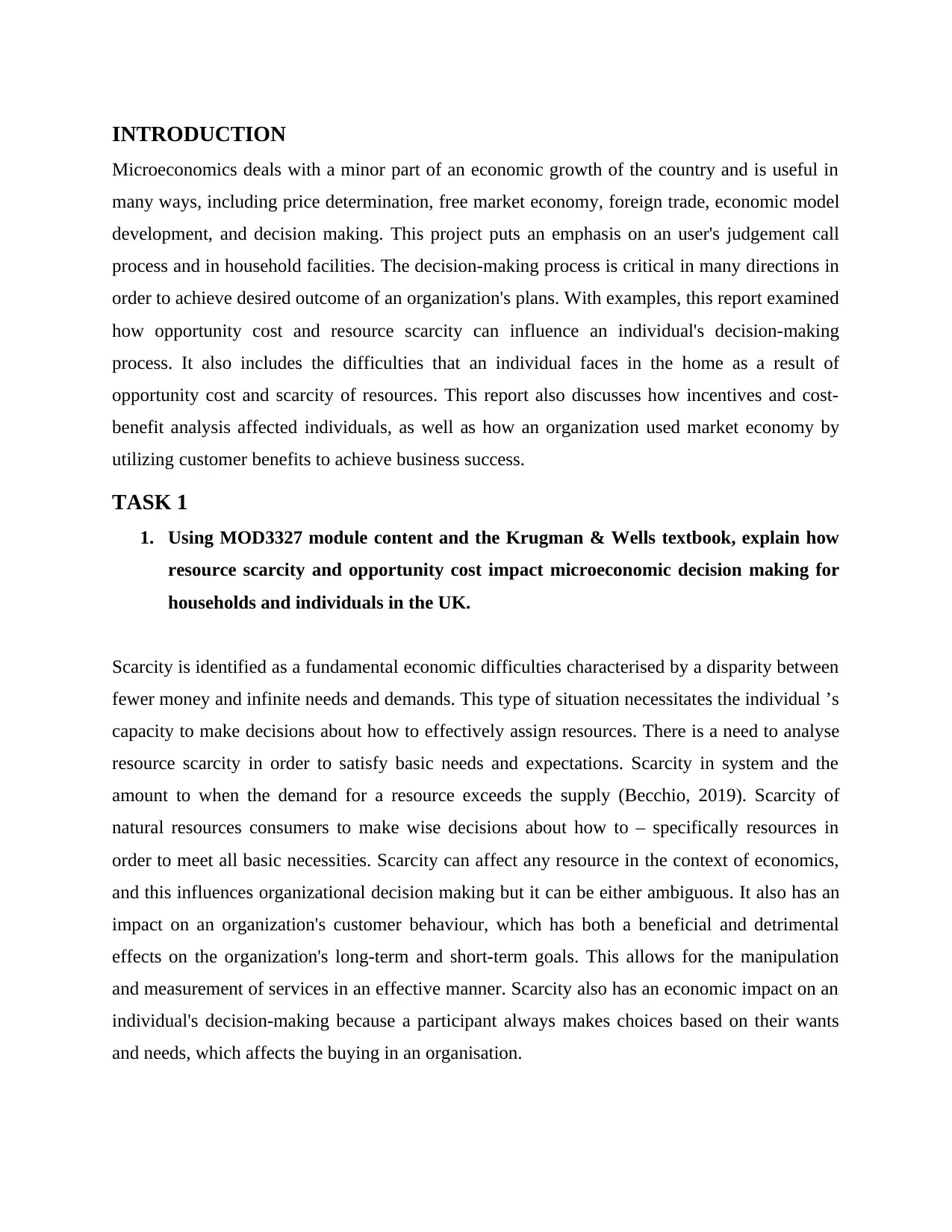
INTRODUCTION
Microeconomics deals with a minor part of an economic growth of the country and is useful in
many ways, including price determination, free market economy, foreign trade, economic model
development, and decision making. This project puts an emphasis on an user's judgement call
process and in household facilities. The decision-making process is critical in many directions in
order to achieve desired outcome of an organization's plans. With examples, this report examined
how opportunity cost and resource scarcity can influence an individual's decision-making
process. It also includes the difficulties that an individual faces in the home as a result of
opportunity cost and scarcity of resources. This report also discusses how incentives and cost-
benefit analysis affected individuals, as well as how an organization used market economy by
utilizing customer benefits to achieve business success.
TASK 1
1. Using MOD3327 module content and the Krugman & Wells textbook, explain how
resource scarcity and opportunity cost impact microeconomic decision making for
households and individuals in the UK.
Scarcity is identified as a fundamental economic difficulties characterised by a disparity between
fewer money and infinite needs and demands. This type of situation necessitates the individual ’s
capacity to make decisions about how to effectively assign resources. There is a need to analyse
resource scarcity in order to satisfy basic needs and expectations. Scarcity in system and the
amount to when the demand for a resource exceeds the supply (Becchio, 2019). Scarcity of
natural resources consumers to make wise decisions about how to – specifically resources in
order to meet all basic necessities. Scarcity can affect any resource in the context of economics,
and this influences organizational decision making but it can be either ambiguous. It also has an
impact on an organization's customer behaviour, which has both a beneficial and detrimental
effects on the organization's long-term and short-term goals. This allows for the manipulation
and measurement of services in an effective manner. Scarcity also has an economic impact on an
individual's decision-making because a participant always makes choices based on their wants
and needs, which affects the buying in an organisation.
Microeconomics deals with a minor part of an economic growth of the country and is useful in
many ways, including price determination, free market economy, foreign trade, economic model
development, and decision making. This project puts an emphasis on an user's judgement call
process and in household facilities. The decision-making process is critical in many directions in
order to achieve desired outcome of an organization's plans. With examples, this report examined
how opportunity cost and resource scarcity can influence an individual's decision-making
process. It also includes the difficulties that an individual faces in the home as a result of
opportunity cost and scarcity of resources. This report also discusses how incentives and cost-
benefit analysis affected individuals, as well as how an organization used market economy by
utilizing customer benefits to achieve business success.
TASK 1
1. Using MOD3327 module content and the Krugman & Wells textbook, explain how
resource scarcity and opportunity cost impact microeconomic decision making for
households and individuals in the UK.
Scarcity is identified as a fundamental economic difficulties characterised by a disparity between
fewer money and infinite needs and demands. This type of situation necessitates the individual ’s
capacity to make decisions about how to effectively assign resources. There is a need to analyse
resource scarcity in order to satisfy basic needs and expectations. Scarcity in system and the
amount to when the demand for a resource exceeds the supply (Becchio, 2019). Scarcity of
natural resources consumers to make wise decisions about how to – specifically resources in
order to meet all basic necessities. Scarcity can affect any resource in the context of economics,
and this influences organizational decision making but it can be either ambiguous. It also has an
impact on an organization's customer behaviour, which has both a beneficial and detrimental
effects on the organization's long-term and short-term goals. This allows for the manipulation
and measurement of services in an effective manner. Scarcity also has an economic impact on an
individual's decision-making because a participant always makes choices based on their wants
and needs, which affects the buying in an organisation.
⊘ This is a preview!⊘
Do you want full access?
Subscribe today to unlock all pages.

Trusted by 1+ million students worldwide
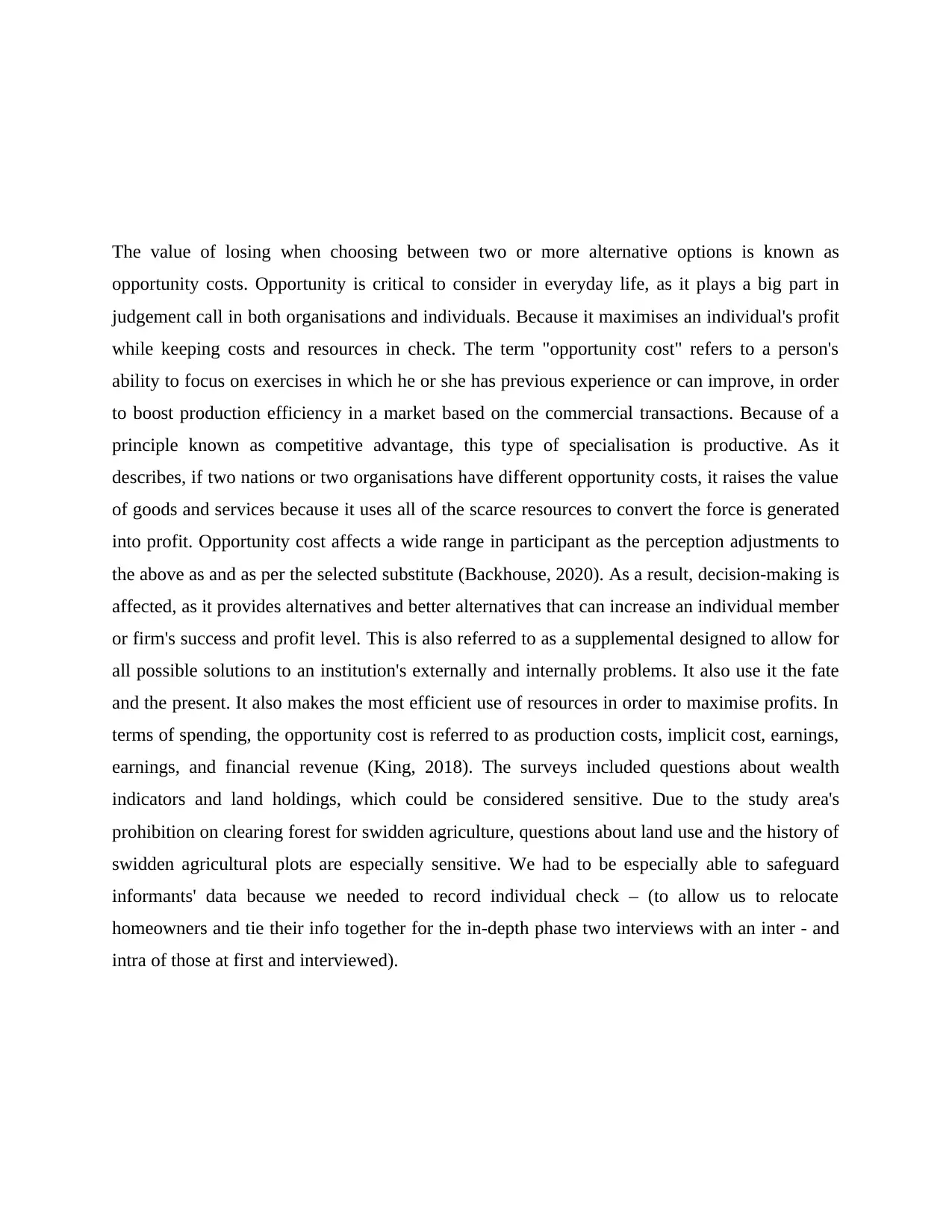
The value of losing when choosing between two or more alternative options is known as
opportunity costs. Opportunity is critical to consider in everyday life, as it plays a big part in
judgement call in both organisations and individuals. Because it maximises an individual's profit
while keeping costs and resources in check. The term "opportunity cost" refers to a person's
ability to focus on exercises in which he or she has previous experience or can improve, in order
to boost production efficiency in a market based on the commercial transactions. Because of a
principle known as competitive advantage, this type of specialisation is productive. As it
describes, if two nations or two organisations have different opportunity costs, it raises the value
of goods and services because it uses all of the scarce resources to convert the force is generated
into profit. Opportunity cost affects a wide range in participant as the perception adjustments to
the above as and as per the selected substitute (Backhouse, 2020). As a result, decision-making is
affected, as it provides alternatives and better alternatives that can increase an individual member
or firm's success and profit level. This is also referred to as a supplemental designed to allow for
all possible solutions to an institution's externally and internally problems. It also use it the fate
and the present. It also makes the most efficient use of resources in order to maximise profits. In
terms of spending, the opportunity cost is referred to as production costs, implicit cost, earnings,
earnings, and financial revenue (King, 2018). The surveys included questions about wealth
indicators and land holdings, which could be considered sensitive. Due to the study area's
prohibition on clearing forest for swidden agriculture, questions about land use and the history of
swidden agricultural plots are especially sensitive. We had to be especially able to safeguard
informants' data because we needed to record individual check – (to allow us to relocate
homeowners and tie their info together for the in-depth phase two interviews with an inter - and
intra of those at first and interviewed).
opportunity costs. Opportunity is critical to consider in everyday life, as it plays a big part in
judgement call in both organisations and individuals. Because it maximises an individual's profit
while keeping costs and resources in check. The term "opportunity cost" refers to a person's
ability to focus on exercises in which he or she has previous experience or can improve, in order
to boost production efficiency in a market based on the commercial transactions. Because of a
principle known as competitive advantage, this type of specialisation is productive. As it
describes, if two nations or two organisations have different opportunity costs, it raises the value
of goods and services because it uses all of the scarce resources to convert the force is generated
into profit. Opportunity cost affects a wide range in participant as the perception adjustments to
the above as and as per the selected substitute (Backhouse, 2020). As a result, decision-making is
affected, as it provides alternatives and better alternatives that can increase an individual member
or firm's success and profit level. This is also referred to as a supplemental designed to allow for
all possible solutions to an institution's externally and internally problems. It also use it the fate
and the present. It also makes the most efficient use of resources in order to maximise profits. In
terms of spending, the opportunity cost is referred to as production costs, implicit cost, earnings,
earnings, and financial revenue (King, 2018). The surveys included questions about wealth
indicators and land holdings, which could be considered sensitive. Due to the study area's
prohibition on clearing forest for swidden agriculture, questions about land use and the history of
swidden agricultural plots are especially sensitive. We had to be especially able to safeguard
informants' data because we needed to record individual check – (to allow us to relocate
homeowners and tie their info together for the in-depth phase two interviews with an inter - and
intra of those at first and interviewed).
Paraphrase This Document
Need a fresh take? Get an instant paraphrase of this document with our AI Paraphraser
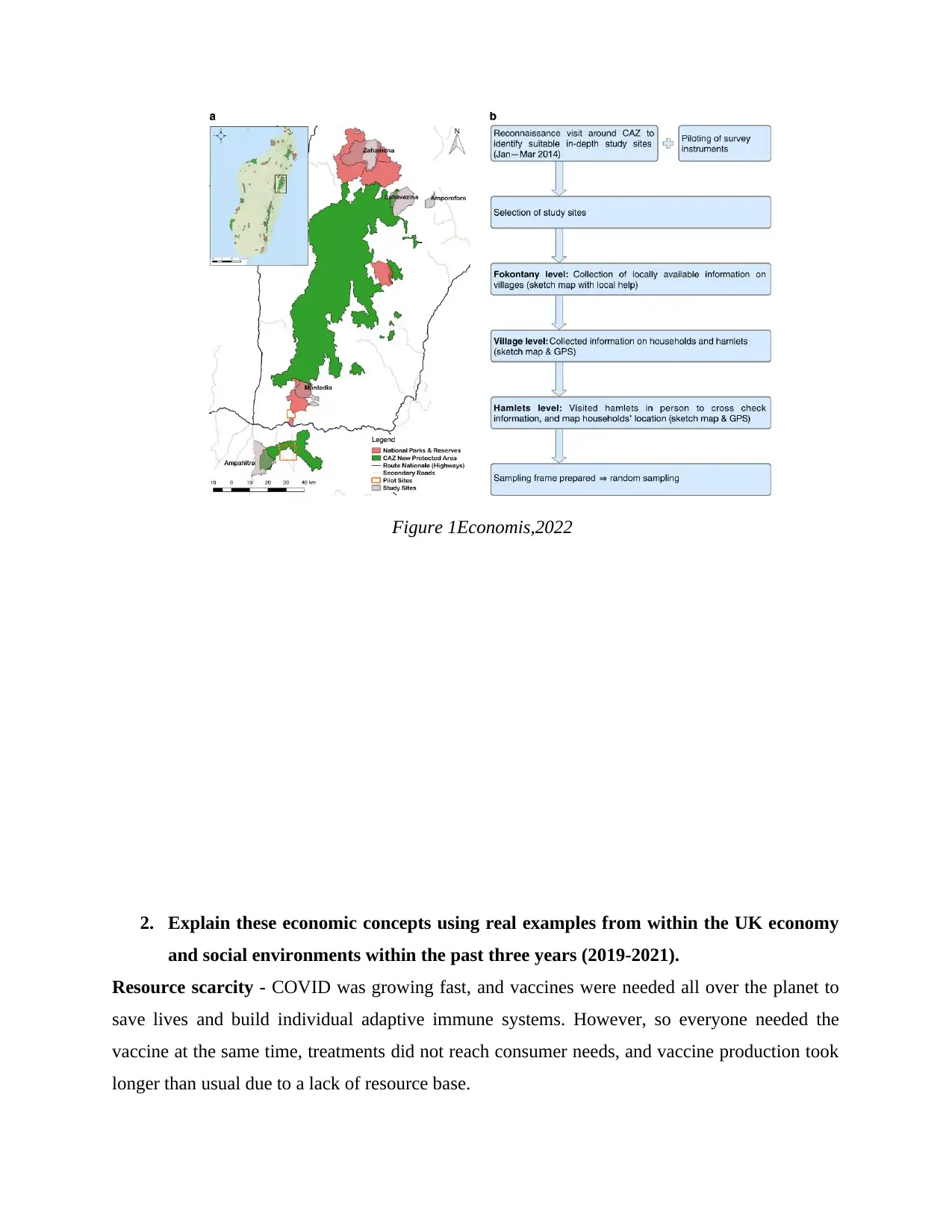
Figure 1Economis,2022
2. Explain these economic concepts using real examples from within the UK economy
and social environments within the past three years (2019-2021).
Resource scarcity - COVID was growing fast, and vaccines were needed all over the planet to
save lives and build individual adaptive immune systems. However, so everyone needed the
vaccine at the same time, treatments did not reach consumer needs, and vaccine production took
longer than usual due to a lack of resource base.
2. Explain these economic concepts using real examples from within the UK economy
and social environments within the past three years (2019-2021).
Resource scarcity - COVID was growing fast, and vaccines were needed all over the planet to
save lives and build individual adaptive immune systems. However, so everyone needed the
vaccine at the same time, treatments did not reach consumer needs, and vaccine production took
longer than usual due to a lack of resource base.
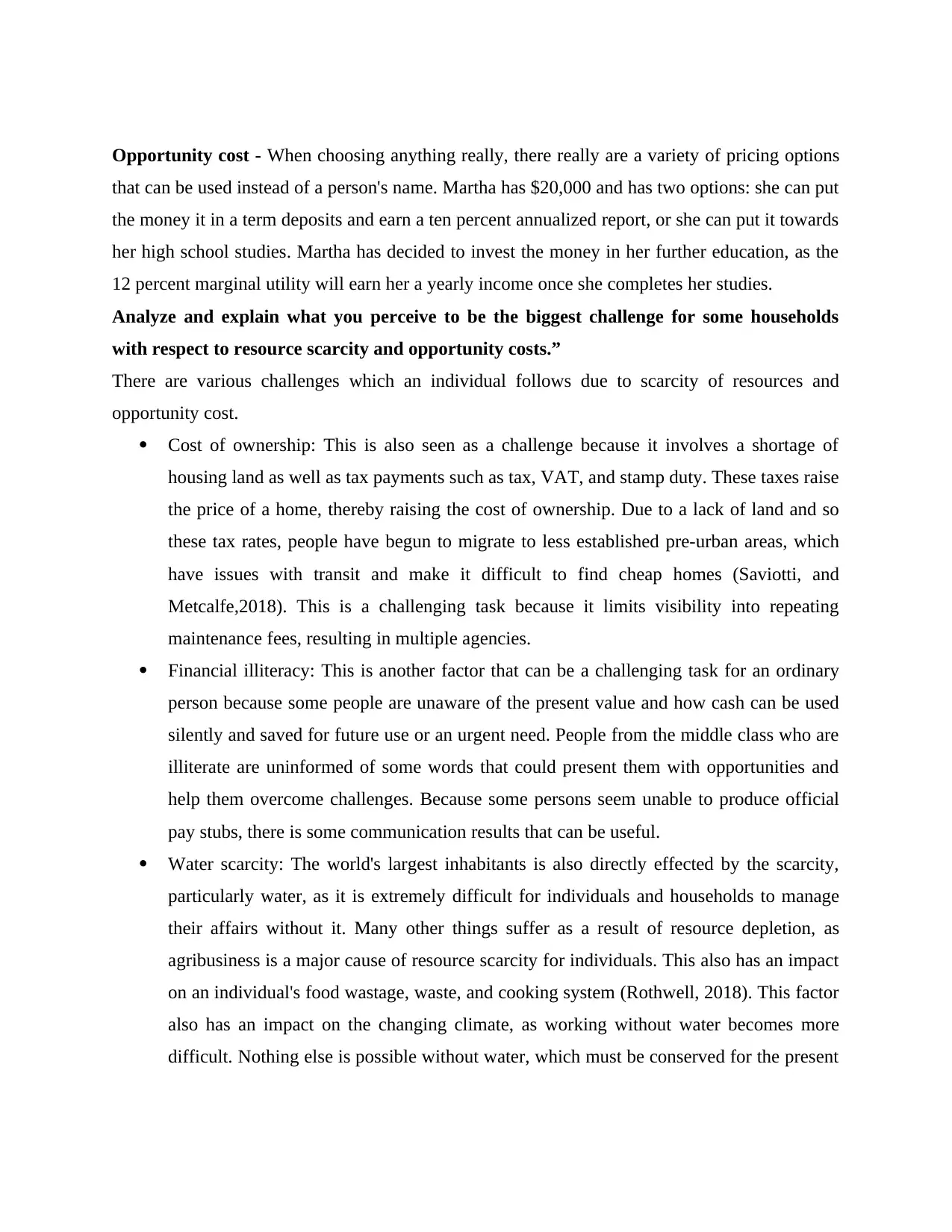
Opportunity cost - When choosing anything really, there really are a variety of pricing options
that can be used instead of a person's name. Martha has $20,000 and has two options: she can put
the money it in a term deposits and earn a ten percent annualized report, or she can put it towards
her high school studies. Martha has decided to invest the money in her further education, as the
12 percent marginal utility will earn her a yearly income once she completes her studies.
Analyze and explain what you perceive to be the biggest challenge for some households
with respect to resource scarcity and opportunity costs.”
There are various challenges which an individual follows due to scarcity of resources and
opportunity cost.
Cost of ownership: This is also seen as a challenge because it involves a shortage of
housing land as well as tax payments such as tax, VAT, and stamp duty. These taxes raise
the price of a home, thereby raising the cost of ownership. Due to a lack of land and so
these tax rates, people have begun to migrate to less established pre-urban areas, which
have issues with transit and make it difficult to find cheap homes (Saviotti, and
Metcalfe,2018). This is a challenging task because it limits visibility into repeating
maintenance fees, resulting in multiple agencies.
Financial illiteracy: This is another factor that can be a challenging task for an ordinary
person because some people are unaware of the present value and how cash can be used
silently and saved for future use or an urgent need. People from the middle class who are
illiterate are uninformed of some words that could present them with opportunities and
help them overcome challenges. Because some persons seem unable to produce official
pay stubs, there is some communication results that can be useful.
Water scarcity: The world's largest inhabitants is also directly effected by the scarcity,
particularly water, as it is extremely difficult for individuals and households to manage
their affairs without it. Many other things suffer as a result of resource depletion, as
agribusiness is a major cause of resource scarcity for individuals. This also has an impact
on an individual's food wastage, waste, and cooking system (Rothwell, 2018). This factor
also has an impact on the changing climate, as working without water becomes more
difficult. Nothing else is possible without water, which must be conserved for the present
that can be used instead of a person's name. Martha has $20,000 and has two options: she can put
the money it in a term deposits and earn a ten percent annualized report, or she can put it towards
her high school studies. Martha has decided to invest the money in her further education, as the
12 percent marginal utility will earn her a yearly income once she completes her studies.
Analyze and explain what you perceive to be the biggest challenge for some households
with respect to resource scarcity and opportunity costs.”
There are various challenges which an individual follows due to scarcity of resources and
opportunity cost.
Cost of ownership: This is also seen as a challenge because it involves a shortage of
housing land as well as tax payments such as tax, VAT, and stamp duty. These taxes raise
the price of a home, thereby raising the cost of ownership. Due to a lack of land and so
these tax rates, people have begun to migrate to less established pre-urban areas, which
have issues with transit and make it difficult to find cheap homes (Saviotti, and
Metcalfe,2018). This is a challenging task because it limits visibility into repeating
maintenance fees, resulting in multiple agencies.
Financial illiteracy: This is another factor that can be a challenging task for an ordinary
person because some people are unaware of the present value and how cash can be used
silently and saved for future use or an urgent need. People from the middle class who are
illiterate are uninformed of some words that could present them with opportunities and
help them overcome challenges. Because some persons seem unable to produce official
pay stubs, there is some communication results that can be useful.
Water scarcity: The world's largest inhabitants is also directly effected by the scarcity,
particularly water, as it is extremely difficult for individuals and households to manage
their affairs without it. Many other things suffer as a result of resource depletion, as
agribusiness is a major cause of resource scarcity for individuals. This also has an impact
on an individual's food wastage, waste, and cooking system (Rothwell, 2018). This factor
also has an impact on the changing climate, as working without water becomes more
difficult. Nothing else is possible without water, which must be conserved for the present
⊘ This is a preview!⊘
Do you want full access?
Subscribe today to unlock all pages.

Trusted by 1+ million students worldwide
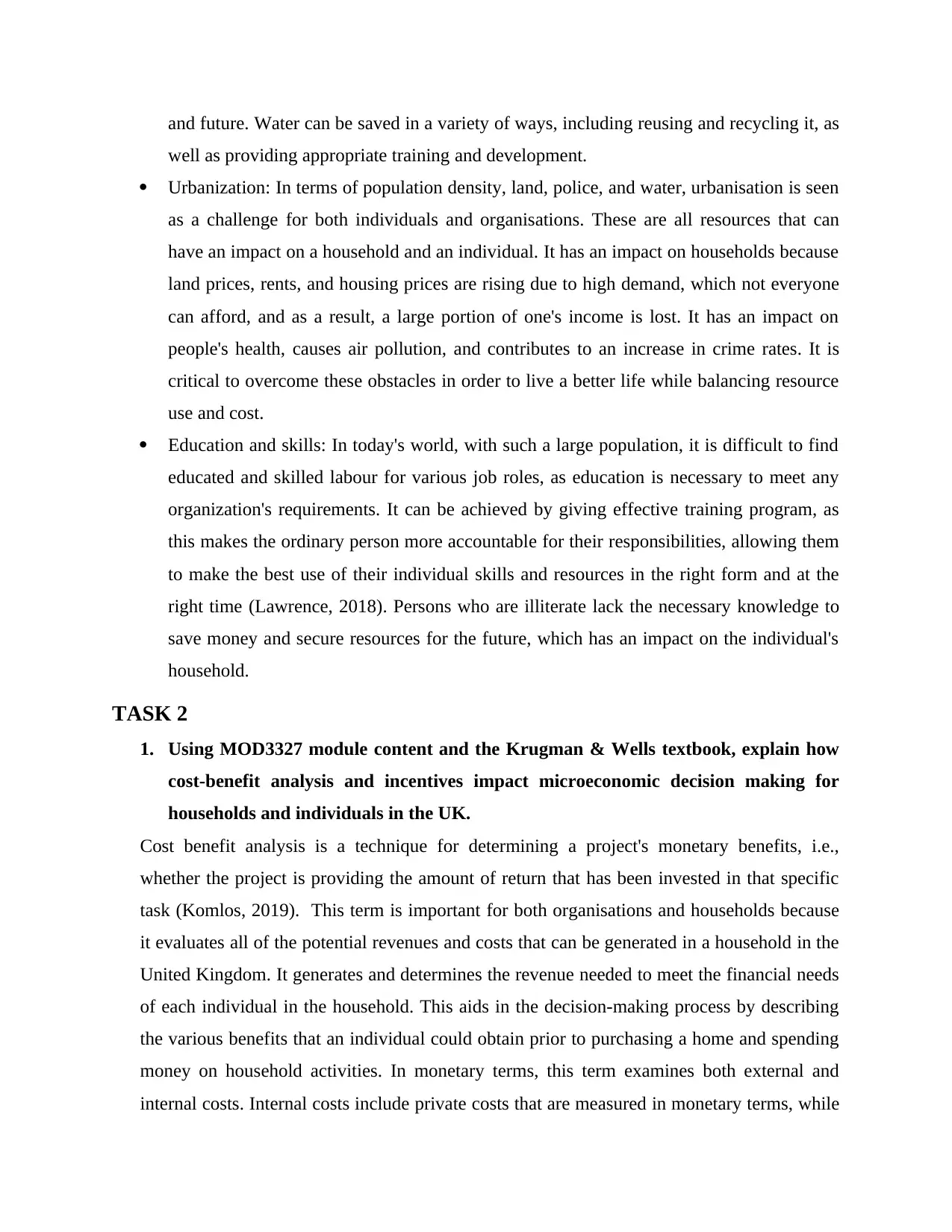
and future. Water can be saved in a variety of ways, including reusing and recycling it, as
well as providing appropriate training and development.
Urbanization: In terms of population density, land, police, and water, urbanisation is seen
as a challenge for both individuals and organisations. These are all resources that can
have an impact on a household and an individual. It has an impact on households because
land prices, rents, and housing prices are rising due to high demand, which not everyone
can afford, and as a result, a large portion of one's income is lost. It has an impact on
people's health, causes air pollution, and contributes to an increase in crime rates. It is
critical to overcome these obstacles in order to live a better life while balancing resource
use and cost.
Education and skills: In today's world, with such a large population, it is difficult to find
educated and skilled labour for various job roles, as education is necessary to meet any
organization's requirements. It can be achieved by giving effective training program, as
this makes the ordinary person more accountable for their responsibilities, allowing them
to make the best use of their individual skills and resources in the right form and at the
right time (Lawrence, 2018). Persons who are illiterate lack the necessary knowledge to
save money and secure resources for the future, which has an impact on the individual's
household.
TASK 2
1. Using MOD3327 module content and the Krugman & Wells textbook, explain how
cost-benefit analysis and incentives impact microeconomic decision making for
households and individuals in the UK.
Cost benefit analysis is a technique for determining a project's monetary benefits, i.e.,
whether the project is providing the amount of return that has been invested in that specific
task (Komlos, 2019). This term is important for both organisations and households because
it evaluates all of the potential revenues and costs that can be generated in a household in the
United Kingdom. It generates and determines the revenue needed to meet the financial needs
of each individual in the household. This aids in the decision-making process by describing
the various benefits that an individual could obtain prior to purchasing a home and spending
money on household activities. In monetary terms, this term examines both external and
internal costs. Internal costs include private costs that are measured in monetary terms, while
well as providing appropriate training and development.
Urbanization: In terms of population density, land, police, and water, urbanisation is seen
as a challenge for both individuals and organisations. These are all resources that can
have an impact on a household and an individual. It has an impact on households because
land prices, rents, and housing prices are rising due to high demand, which not everyone
can afford, and as a result, a large portion of one's income is lost. It has an impact on
people's health, causes air pollution, and contributes to an increase in crime rates. It is
critical to overcome these obstacles in order to live a better life while balancing resource
use and cost.
Education and skills: In today's world, with such a large population, it is difficult to find
educated and skilled labour for various job roles, as education is necessary to meet any
organization's requirements. It can be achieved by giving effective training program, as
this makes the ordinary person more accountable for their responsibilities, allowing them
to make the best use of their individual skills and resources in the right form and at the
right time (Lawrence, 2018). Persons who are illiterate lack the necessary knowledge to
save money and secure resources for the future, which has an impact on the individual's
household.
TASK 2
1. Using MOD3327 module content and the Krugman & Wells textbook, explain how
cost-benefit analysis and incentives impact microeconomic decision making for
households and individuals in the UK.
Cost benefit analysis is a technique for determining a project's monetary benefits, i.e.,
whether the project is providing the amount of return that has been invested in that specific
task (Komlos, 2019). This term is important for both organisations and households because
it evaluates all of the potential revenues and costs that can be generated in a household in the
United Kingdom. It generates and determines the revenue needed to meet the financial needs
of each individual in the household. This aids in the decision-making process by describing
the various benefits that an individual could obtain prior to purchasing a home and spending
money on household activities. In monetary terms, this term examines both external and
internal costs. Internal costs include private costs that are measured in monetary terms, while
Paraphrase This Document
Need a fresh take? Get an instant paraphrase of this document with our AI Paraphraser
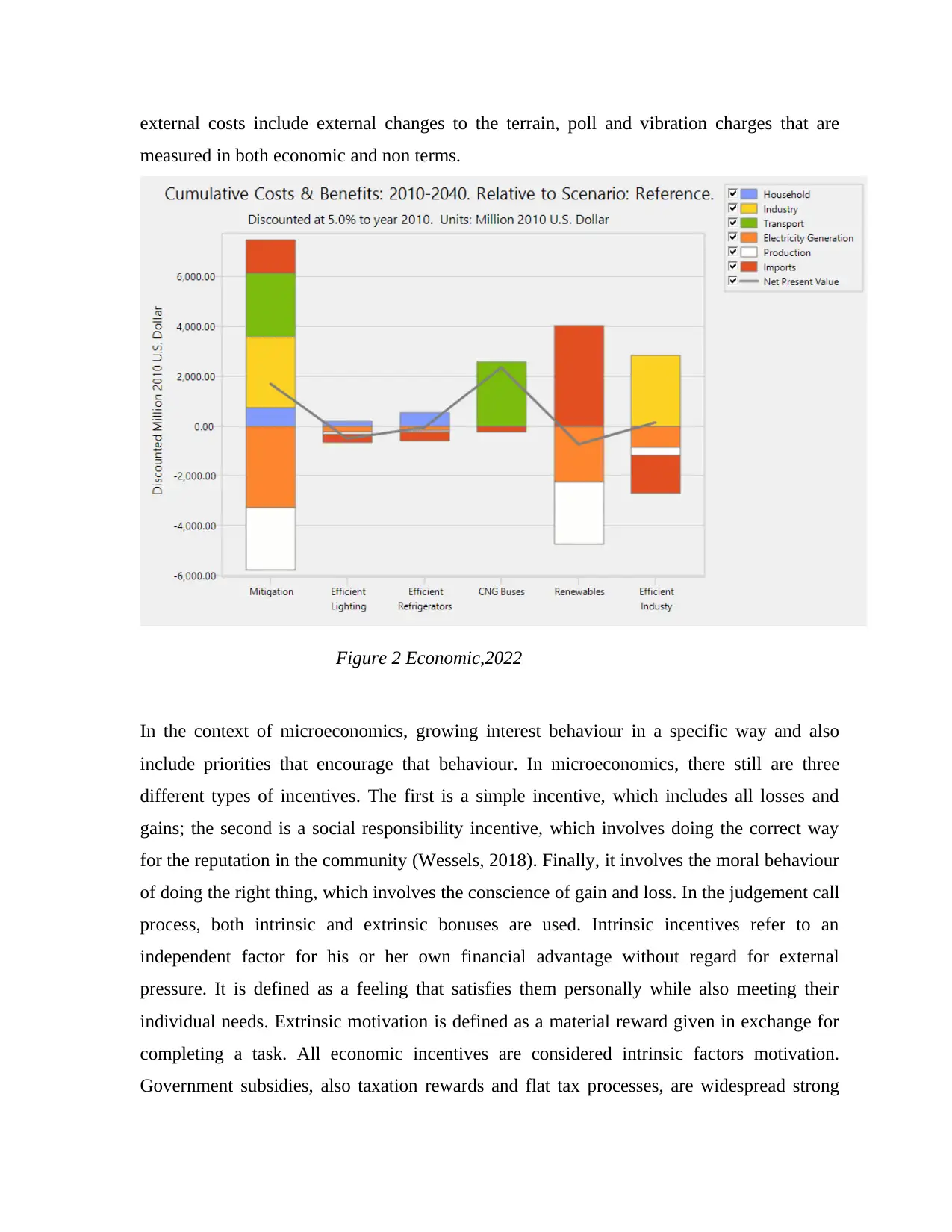
external costs include external changes to the terrain, poll and vibration charges that are
measured in both economic and non terms.
Figure 2 Economic,2022
In the context of microeconomics, growing interest behaviour in a specific way and also
include priorities that encourage that behaviour. In microeconomics, there still are three
different types of incentives. The first is a simple incentive, which includes all losses and
gains; the second is a social responsibility incentive, which involves doing the correct way
for the reputation in the community (Wessels, 2018). Finally, it involves the moral behaviour
of doing the right thing, which involves the conscience of gain and loss. In the judgement call
process, both intrinsic and extrinsic bonuses are used. Intrinsic incentives refer to an
independent factor for his or her own financial advantage without regard for external
pressure. It is defined as a feeling that satisfies them personally while also meeting their
individual needs. Extrinsic motivation is defined as a material reward given in exchange for
completing a task. All economic incentives are considered intrinsic factors motivation.
Government subsidies, also taxation rewards and flat tax processes, are widespread strong
measured in both economic and non terms.
Figure 2 Economic,2022
In the context of microeconomics, growing interest behaviour in a specific way and also
include priorities that encourage that behaviour. In microeconomics, there still are three
different types of incentives. The first is a simple incentive, which includes all losses and
gains; the second is a social responsibility incentive, which involves doing the correct way
for the reputation in the community (Wessels, 2018). Finally, it involves the moral behaviour
of doing the right thing, which involves the conscience of gain and loss. In the judgement call
process, both intrinsic and extrinsic bonuses are used. Intrinsic incentives refer to an
independent factor for his or her own financial advantage without regard for external
pressure. It is defined as a feeling that satisfies them personally while also meeting their
individual needs. Extrinsic motivation is defined as a material reward given in exchange for
completing a task. All economic incentives are considered intrinsic factors motivation.
Government subsidies, also taxation rewards and flat tax processes, are widespread strong
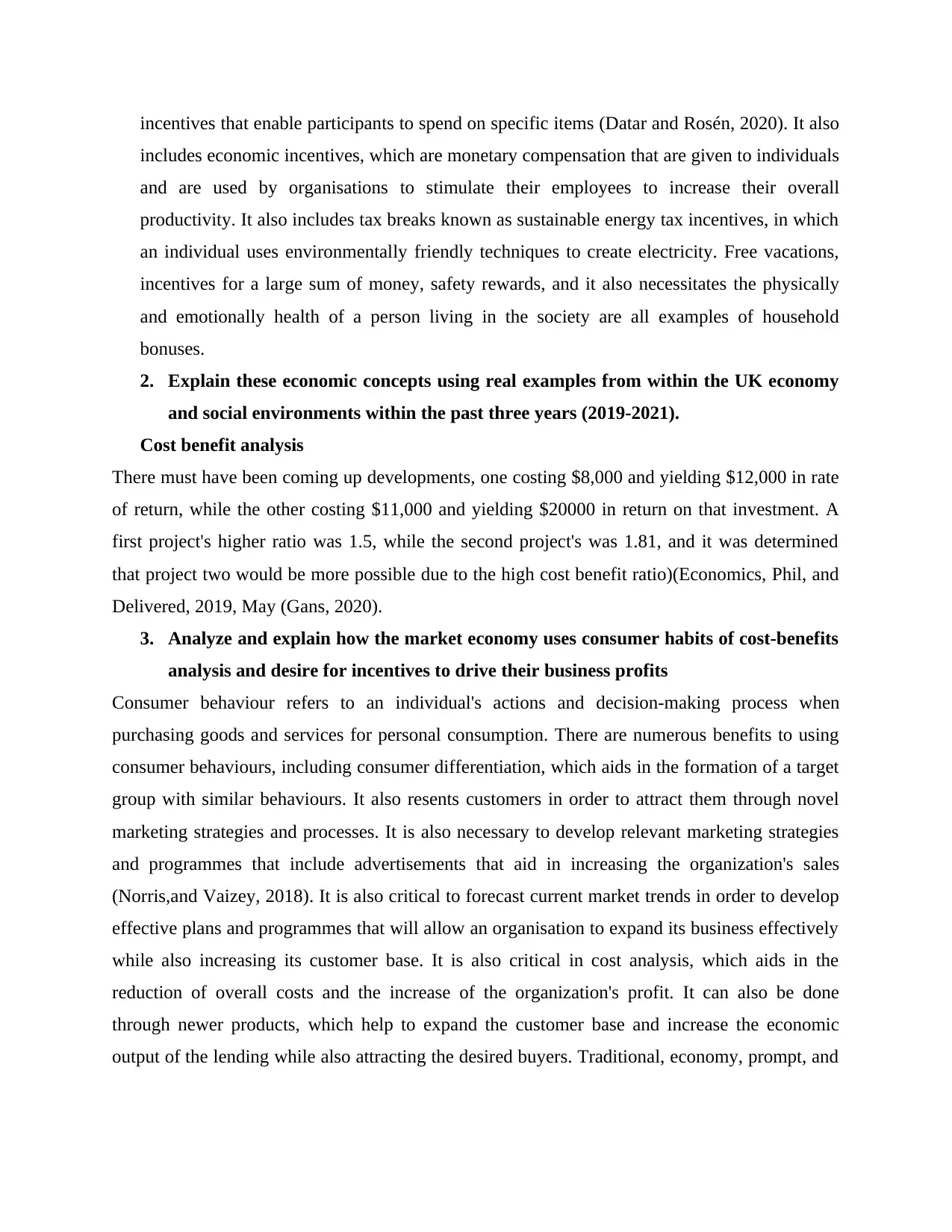
incentives that enable participants to spend on specific items (Datar and Rosén, 2020). It also
includes economic incentives, which are monetary compensation that are given to individuals
and are used by organisations to stimulate their employees to increase their overall
productivity. It also includes tax breaks known as sustainable energy tax incentives, in which
an individual uses environmentally friendly techniques to create electricity. Free vacations,
incentives for a large sum of money, safety rewards, and it also necessitates the physically
and emotionally health of a person living in the society are all examples of household
bonuses.
2. Explain these economic concepts using real examples from within the UK economy
and social environments within the past three years (2019-2021).
Cost benefit analysis
There must have been coming up developments, one costing $8,000 and yielding $12,000 in rate
of return, while the other costing $11,000 and yielding $20000 in return on that investment. A
first project's higher ratio was 1.5, while the second project's was 1.81, and it was determined
that project two would be more possible due to the high cost benefit ratio)(Economics, Phil, and
Delivered, 2019, May (Gans, 2020).
3. Analyze and explain how the market economy uses consumer habits of cost-benefits
analysis and desire for incentives to drive their business profits
Consumer behaviour refers to an individual's actions and decision-making process when
purchasing goods and services for personal consumption. There are numerous benefits to using
consumer behaviours, including consumer differentiation, which aids in the formation of a target
group with similar behaviours. It also resents customers in order to attract them through novel
marketing strategies and processes. It is also necessary to develop relevant marketing strategies
and programmes that include advertisements that aid in increasing the organization's sales
(Norris,and Vaizey, 2018). It is also critical to forecast current market trends in order to develop
effective plans and programmes that will allow an organisation to expand its business effectively
while also increasing its customer base. It is also critical in cost analysis, which aids in the
reduction of overall costs and the increase of the organization's profit. It can also be done
through newer products, which help to expand the customer base and increase the economic
output of the lending while also attracting the desired buyers. Traditional, economy, prompt, and
includes economic incentives, which are monetary compensation that are given to individuals
and are used by organisations to stimulate their employees to increase their overall
productivity. It also includes tax breaks known as sustainable energy tax incentives, in which
an individual uses environmentally friendly techniques to create electricity. Free vacations,
incentives for a large sum of money, safety rewards, and it also necessitates the physically
and emotionally health of a person living in the society are all examples of household
bonuses.
2. Explain these economic concepts using real examples from within the UK economy
and social environments within the past three years (2019-2021).
Cost benefit analysis
There must have been coming up developments, one costing $8,000 and yielding $12,000 in rate
of return, while the other costing $11,000 and yielding $20000 in return on that investment. A
first project's higher ratio was 1.5, while the second project's was 1.81, and it was determined
that project two would be more possible due to the high cost benefit ratio)(Economics, Phil, and
Delivered, 2019, May (Gans, 2020).
3. Analyze and explain how the market economy uses consumer habits of cost-benefits
analysis and desire for incentives to drive their business profits
Consumer behaviour refers to an individual's actions and decision-making process when
purchasing goods and services for personal consumption. There are numerous benefits to using
consumer behaviours, including consumer differentiation, which aids in the formation of a target
group with similar behaviours. It also resents customers in order to attract them through novel
marketing strategies and processes. It is also necessary to develop relevant marketing strategies
and programmes that include advertisements that aid in increasing the organization's sales
(Norris,and Vaizey, 2018). It is also critical to forecast current market trends in order to develop
effective plans and programmes that will allow an organisation to expand its business effectively
while also increasing its customer base. It is also critical in cost analysis, which aids in the
reduction of overall costs and the increase of the organization's profit. It can also be done
through newer products, which help to expand the customer base and increase the economic
output of the lending while also attracting the desired buyers. Traditional, economy, prompt, and
⊘ This is a preview!⊘
Do you want full access?
Subscribe today to unlock all pages.

Trusted by 1+ million students worldwide
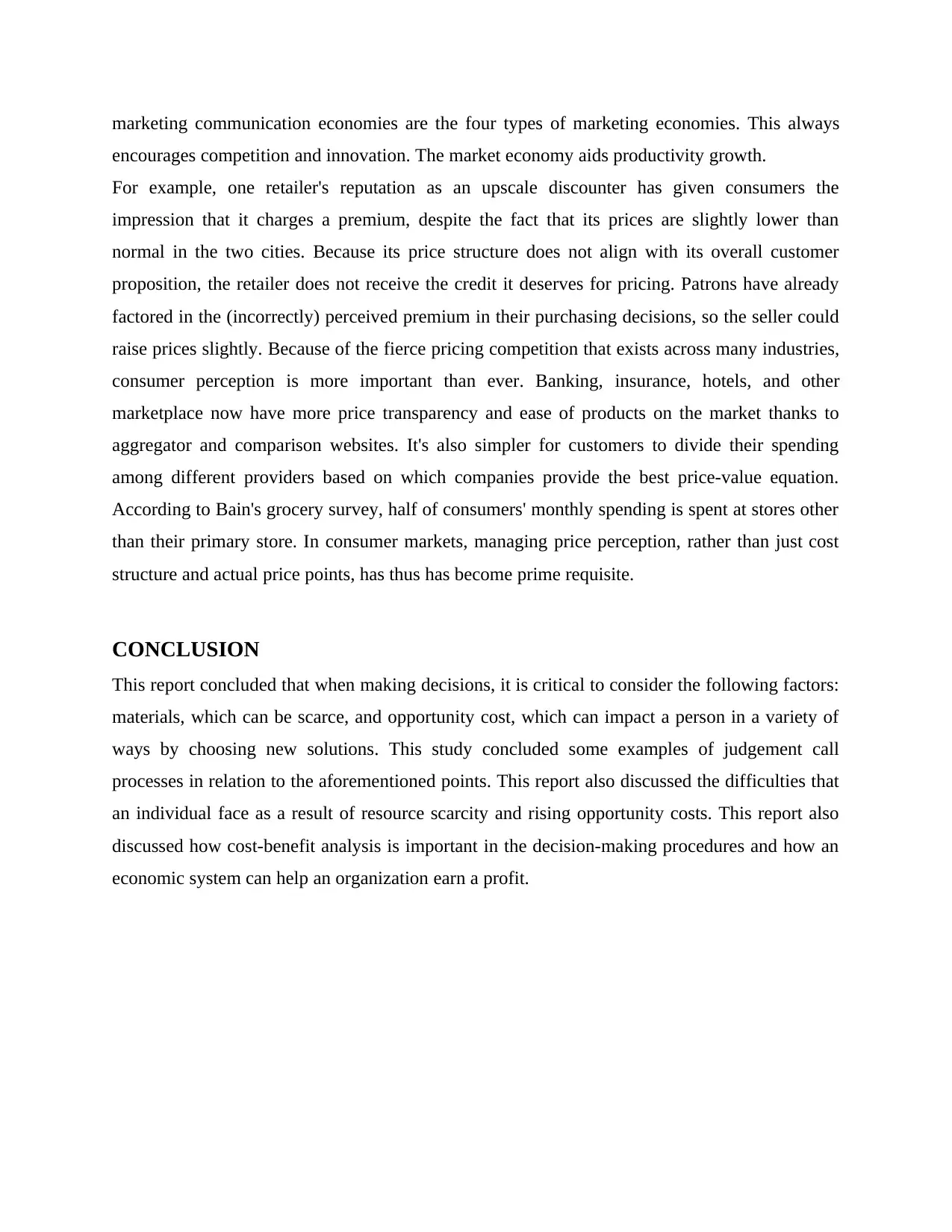
marketing communication economies are the four types of marketing economies. This always
encourages competition and innovation. The market economy aids productivity growth.
For example, one retailer's reputation as an upscale discounter has given consumers the
impression that it charges a premium, despite the fact that its prices are slightly lower than
normal in the two cities. Because its price structure does not align with its overall customer
proposition, the retailer does not receive the credit it deserves for pricing. Patrons have already
factored in the (incorrectly) perceived premium in their purchasing decisions, so the seller could
raise prices slightly. Because of the fierce pricing competition that exists across many industries,
consumer perception is more important than ever. Banking, insurance, hotels, and other
marketplace now have more price transparency and ease of products on the market thanks to
aggregator and comparison websites. It's also simpler for customers to divide their spending
among different providers based on which companies provide the best price-value equation.
According to Bain's grocery survey, half of consumers' monthly spending is spent at stores other
than their primary store. In consumer markets, managing price perception, rather than just cost
structure and actual price points, has thus has become prime requisite.
CONCLUSION
This report concluded that when making decisions, it is critical to consider the following factors:
materials, which can be scarce, and opportunity cost, which can impact a person in a variety of
ways by choosing new solutions. This study concluded some examples of judgement call
processes in relation to the aforementioned points. This report also discussed the difficulties that
an individual face as a result of resource scarcity and rising opportunity costs. This report also
discussed how cost-benefit analysis is important in the decision-making procedures and how an
economic system can help an organization earn a profit.
encourages competition and innovation. The market economy aids productivity growth.
For example, one retailer's reputation as an upscale discounter has given consumers the
impression that it charges a premium, despite the fact that its prices are slightly lower than
normal in the two cities. Because its price structure does not align with its overall customer
proposition, the retailer does not receive the credit it deserves for pricing. Patrons have already
factored in the (incorrectly) perceived premium in their purchasing decisions, so the seller could
raise prices slightly. Because of the fierce pricing competition that exists across many industries,
consumer perception is more important than ever. Banking, insurance, hotels, and other
marketplace now have more price transparency and ease of products on the market thanks to
aggregator and comparison websites. It's also simpler for customers to divide their spending
among different providers based on which companies provide the best price-value equation.
According to Bain's grocery survey, half of consumers' monthly spending is spent at stores other
than their primary store. In consumer markets, managing price perception, rather than just cost
structure and actual price points, has thus has become prime requisite.
CONCLUSION
This report concluded that when making decisions, it is critical to consider the following factors:
materials, which can be scarce, and opportunity cost, which can impact a person in a variety of
ways by choosing new solutions. This study concluded some examples of judgement call
processes in relation to the aforementioned points. This report also discussed the difficulties that
an individual face as a result of resource scarcity and rising opportunity costs. This report also
discussed how cost-benefit analysis is important in the decision-making procedures and how an
economic system can help an organization earn a profit.
Paraphrase This Document
Need a fresh take? Get an instant paraphrase of this document with our AI Paraphraser
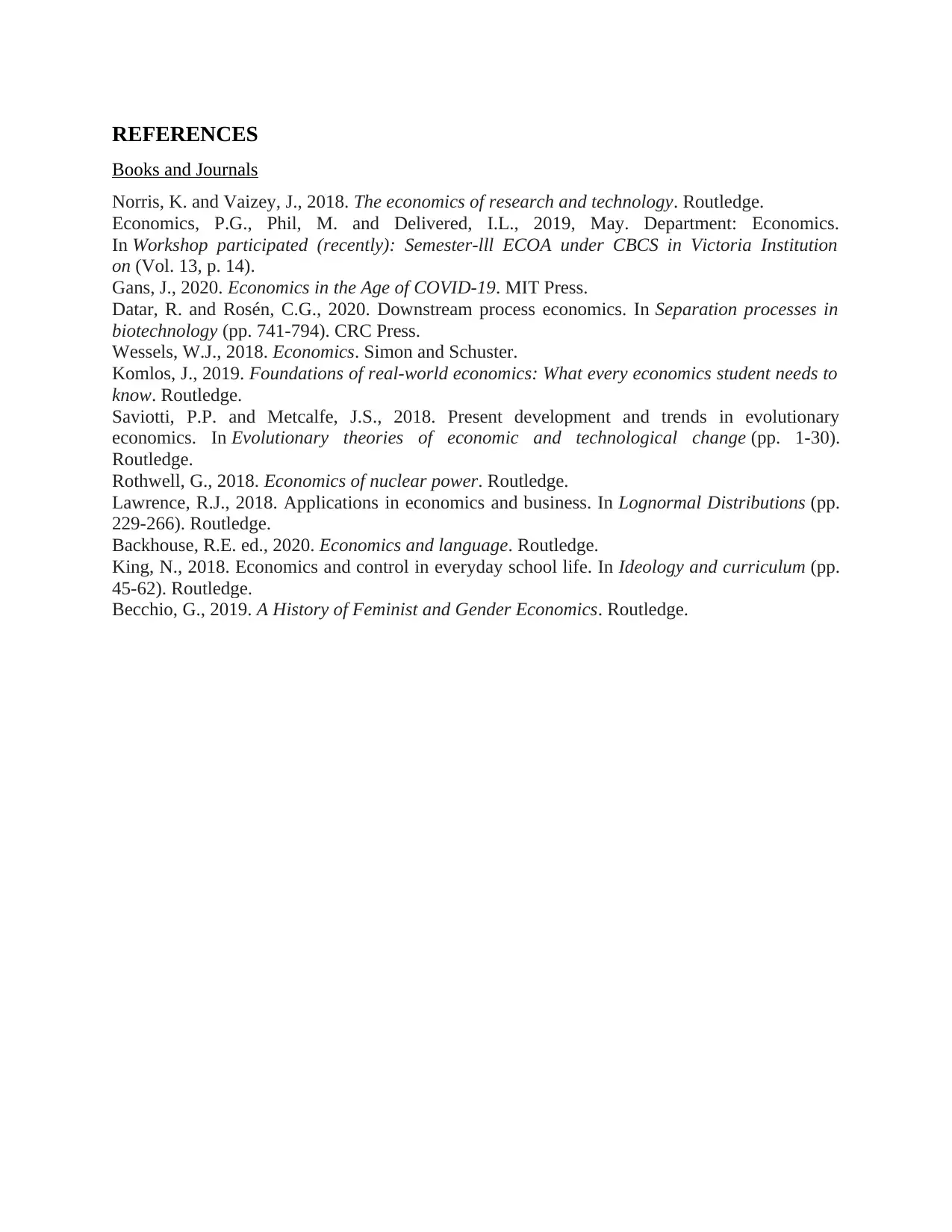
REFERENCES
Books and Journals
Norris, K. and Vaizey, J., 2018. The economics of research and technology. Routledge.
Economics, P.G., Phil, M. and Delivered, I.L., 2019, May. Department: Economics.
In Workshop participated (recently): Semester-lll ECOA under CBCS in Victoria Institution
on (Vol. 13, p. 14).
Gans, J., 2020. Economics in the Age of COVID-19. MIT Press.
Datar, R. and Rosén, C.G., 2020. Downstream process economics. In Separation processes in
biotechnology (pp. 741-794). CRC Press.
Wessels, W.J., 2018. Economics. Simon and Schuster.
Komlos, J., 2019. Foundations of real-world economics: What every economics student needs to
know. Routledge.
Saviotti, P.P. and Metcalfe, J.S., 2018. Present development and trends in evolutionary
economics. In Evolutionary theories of economic and technological change (pp. 1-30).
Routledge.
Rothwell, G., 2018. Economics of nuclear power. Routledge.
Lawrence, R.J., 2018. Applications in economics and business. In Lognormal Distributions (pp.
229-266). Routledge.
Backhouse, R.E. ed., 2020. Economics and language. Routledge.
King, N., 2018. Economics and control in everyday school life. In Ideology and curriculum (pp.
45-62). Routledge.
Becchio, G., 2019. A History of Feminist and Gender Economics. Routledge.
Books and Journals
Norris, K. and Vaizey, J., 2018. The economics of research and technology. Routledge.
Economics, P.G., Phil, M. and Delivered, I.L., 2019, May. Department: Economics.
In Workshop participated (recently): Semester-lll ECOA under CBCS in Victoria Institution
on (Vol. 13, p. 14).
Gans, J., 2020. Economics in the Age of COVID-19. MIT Press.
Datar, R. and Rosén, C.G., 2020. Downstream process economics. In Separation processes in
biotechnology (pp. 741-794). CRC Press.
Wessels, W.J., 2018. Economics. Simon and Schuster.
Komlos, J., 2019. Foundations of real-world economics: What every economics student needs to
know. Routledge.
Saviotti, P.P. and Metcalfe, J.S., 2018. Present development and trends in evolutionary
economics. In Evolutionary theories of economic and technological change (pp. 1-30).
Routledge.
Rothwell, G., 2018. Economics of nuclear power. Routledge.
Lawrence, R.J., 2018. Applications in economics and business. In Lognormal Distributions (pp.
229-266). Routledge.
Backhouse, R.E. ed., 2020. Economics and language. Routledge.
King, N., 2018. Economics and control in everyday school life. In Ideology and curriculum (pp.
45-62). Routledge.
Becchio, G., 2019. A History of Feminist and Gender Economics. Routledge.
1 out of 11
Related Documents
Your All-in-One AI-Powered Toolkit for Academic Success.
+13062052269
info@desklib.com
Available 24*7 on WhatsApp / Email
![[object Object]](/_next/static/media/star-bottom.7253800d.svg)
Unlock your academic potential
Copyright © 2020–2025 A2Z Services. All Rights Reserved. Developed and managed by ZUCOL.


